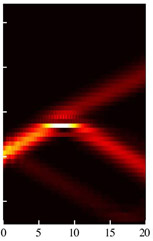Home > Press > Coupled particles cross energy wall: Model demonstrates that it is possible for two particles to cross an energy barrier together, where a single particle could not
 |
Abstract:
For the first time, a new kind of so-called Klein tunnelling—representing the quantum equivalent of crossing an energy wall— has been presented in a model of two interacting particles. This work by Stefano Longhi and Giuseppe Della Valle from the Institute of Photonics and Nanotechnology in Milan, Italy, is about to be published in EPJ B.
Coupled particles cross energy wall: Model demonstrates that it is possible for two particles to cross an energy barrier together, where a single particle could not
New York, NY and Heidelberg, Germany | Posted on May 30th, 2013Klein tunnelling is a quantum phenomenon referring to the fact that a high-potential barrier can be transparent to a particle moving at a speed nearing that of light, referred to as relativistic. Most of the previous Klein tunnelling models describe the phenomenon for a single particle. However, when two particles are involved, tunnelling can be modified as a result of their mutual interaction. This means, for example, that two electrons hopping on a lattice, or two ultra-cold atoms trapped in an optical lattice can exchange energy when they occupy the same lattice site.
The authors relied on an analytical and numerical study of a landmark model of interacting particles, called the Hubbard model. It is typically used to describe particle pairs in condensed matter such as in semi-conductors and in so-called matter wave physics, used for instance to describe microscopic particles oscillating between their material and wave-like characteristics. Longhi and Della Valle predict a new type of Klein tunnelling for a couple of interacting particles confronted by an energy barrier. Even though the barrier is impenetrable for single particles, it becomes transparent when the two particles cross the energy barrier together.
They expect these predictions to be confirmed experimentally in ultra-cold atoms trapped in optical lattices. If this is the case, similar quantum simulation could be a tool for emulating multiple-particle systems that cannot be modelled using classical computations.
####
For more information, please click here
Contacts:
Sophia Grein
49-622-148-78414
Copyright © Springer
If you have a comment, please Contact us.Issuers of news releases, not 7th Wave, Inc. or Nanotechnology Now, are solely responsible for the accuracy of the content.
| Related Links |
| Related News Press |
News and information
![]() Researchers develop molecular qubits that communicate at telecom frequencies October 3rd, 2025
Researchers develop molecular qubits that communicate at telecom frequencies October 3rd, 2025
![]() Next-generation quantum communication October 3rd, 2025
Next-generation quantum communication October 3rd, 2025
![]() "Nanoreactor" cage uses visible light for catalytic and ultra-selective cross-cycloadditions October 3rd, 2025
"Nanoreactor" cage uses visible light for catalytic and ultra-selective cross-cycloadditions October 3rd, 2025
Physics
![]() Quantum computers simulate fundamental physics: shedding light on the building blocks of nature June 6th, 2025
Quantum computers simulate fundamental physics: shedding light on the building blocks of nature June 6th, 2025
![]() A 1960s idea inspires NBI researchers to study hitherto inaccessible quantum states June 6th, 2025
A 1960s idea inspires NBI researchers to study hitherto inaccessible quantum states June 6th, 2025
![]() Magnetism in new exotic material opens the way for robust quantum computers June 4th, 2025
Magnetism in new exotic material opens the way for robust quantum computers June 4th, 2025
Discoveries
![]() Researchers develop molecular qubits that communicate at telecom frequencies October 3rd, 2025
Researchers develop molecular qubits that communicate at telecom frequencies October 3rd, 2025
![]() Next-generation quantum communication October 3rd, 2025
Next-generation quantum communication October 3rd, 2025
![]() "Nanoreactor" cage uses visible light for catalytic and ultra-selective cross-cycloadditions October 3rd, 2025
"Nanoreactor" cage uses visible light for catalytic and ultra-selective cross-cycloadditions October 3rd, 2025
Announcements
![]() Rice membrane extracts lithium from brines with greater speed, less waste October 3rd, 2025
Rice membrane extracts lithium from brines with greater speed, less waste October 3rd, 2025
![]() Researchers develop molecular qubits that communicate at telecom frequencies October 3rd, 2025
Researchers develop molecular qubits that communicate at telecom frequencies October 3rd, 2025
![]() Next-generation quantum communication October 3rd, 2025
Next-generation quantum communication October 3rd, 2025
![]() "Nanoreactor" cage uses visible light for catalytic and ultra-selective cross-cycloadditions October 3rd, 2025
"Nanoreactor" cage uses visible light for catalytic and ultra-selective cross-cycloadditions October 3rd, 2025
Interviews/Book Reviews/Essays/Reports/Podcasts/Journals/White papers/Posters
![]() Spinel-type sulfide semiconductors to operate the next-generation LEDs and solar cells For solar-cell absorbers and green-LED source October 3rd, 2025
Spinel-type sulfide semiconductors to operate the next-generation LEDs and solar cells For solar-cell absorbers and green-LED source October 3rd, 2025
![]() Rice membrane extracts lithium from brines with greater speed, less waste October 3rd, 2025
Rice membrane extracts lithium from brines with greater speed, less waste October 3rd, 2025
Quantum nanoscience
![]() ICFO researchers overcome long-standing bottleneck in single photon detection with twisted 2D materials August 8th, 2025
ICFO researchers overcome long-standing bottleneck in single photon detection with twisted 2D materials August 8th, 2025
![]() Programmable electron-induced color router array May 14th, 2025
Programmable electron-induced color router array May 14th, 2025
|
|
||
|
|
||
| The latest news from around the world, FREE | ||
|
|
||
|
|
||
| Premium Products | ||
|
|
||
|
Only the news you want to read!
Learn More |
||
|
|
||
|
Full-service, expert consulting
Learn More |
||
|
|
||








